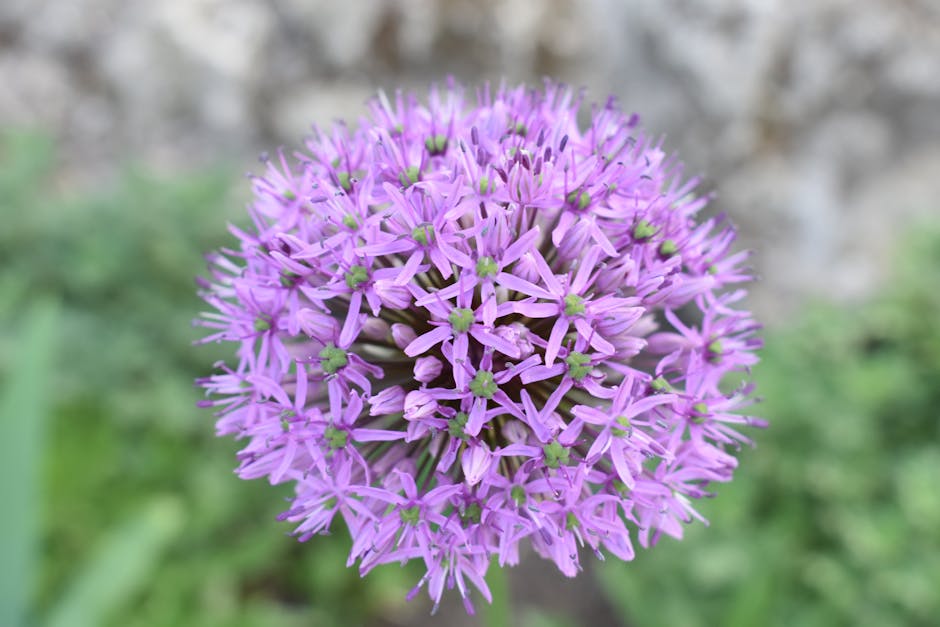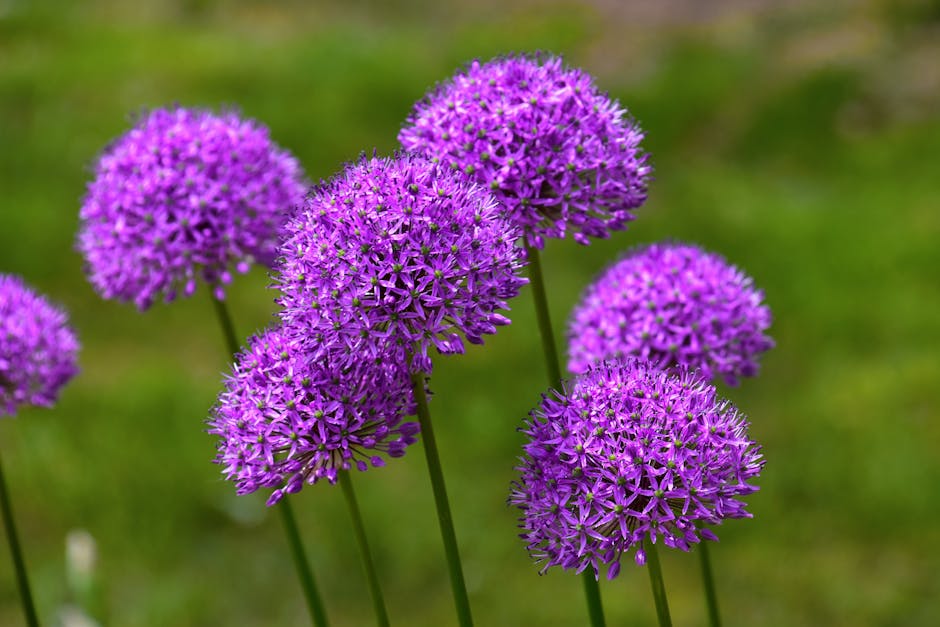Delving into the world of gardening brings us face to face with a myriad of plant choices, each offering its own contribution to the beauty and biodiversity of our outdoor spaces. Among these, Allium ‘Medusa’ stands out, not just for its striking appearance but for its role in supporting the garden’s ecosystem. This discussion aims to shed light on how this particular plant not only enhances the visual appeal of our gardens but also plays a crucial part in nurturing local wildlife, offering a dual benefit that’s hard to overlook.
Overview
Allium 'Medusa', commonly known as Ornamental Onion, is a standout in the garden for several reasons. At 20-24 inches in height and width, this bulbous perennial boasts 2-inch clusters of amethyst-purple flowers. Blooming from late summer to early fall, it provides a burst of color when many other plants are starting to fade. Its unique feature is the flowers that open from nodding buds resembling snakes at the tips of stems, mimicking the mythical hair of Medusa. This lends an air of whimsy to the garden and grabs the attention of anyone passing by.
The plant sits atop sturdy stems, allowing the blossoms to appear as if they're floating above a mound of low, twisting, and curling gray-green leaves. When these leaves are bruised, they release a light onion scent, a gentle reminder of the plant's lineage within the onion family. Despite its delicate appearance, Allium 'Medusa' is easy to grow, carefree, and resistant to deer and rabbits—a true soldier in the garden against these common pests.1
Not only does this perennial add beauty to the landscape, but it also supports local wildlife. Its rich nectar attracts bees, butterflies, and even moths, making it an important player in the garden's ecosystem. Despite its attractiveness to pollinators, it remains generally pest and disease-free, though it's wise to keep an eye out for onion white rot and downy mildew.
Allium 'Medusa' makes an excellent cut flower, adding an unexpected and eye-catching element to arrangements. If left in the garden, its flowers lead to architectural seedheads, extending its interest into the winter months. Propagation is straightforward; simply remove offsets in autumn to plant elsewhere or share with friends.
Its requirements are few: fertile, well-drained soil in full sun to part shade. If dealing with clay soils, the addition of grit can improve its habitat. Once established, it is drought tolerant, thriving through dry summers with ease.
Ideal for rock gardens, herb gardens, and as a border plant, 'Medusa' shines when planted in clusters for a visually striking effect. It's an exemplar of how the right plant can blend whimsy, wildlife support, and low maintenance into one outstanding garden specimen.

Growth & Care
When adding Allium 'Medusa' to your garden, attention to spacing and companions is crucial for maximal impact. Plant Medusa about 16 inches apart from center to center, allowing enough room for each plant to mature fully, enhancing air movement around the leaves and reducing the chance of plant diseases.
Choosing companions for Medusa can be a creative endeavor. Pair them with plants that offer contrasting colors or textures for a garden that pops. Consider partnering Medusa with yellows like Coreopsis, Daylilies, or Black-Eyed Susans. Their stunning purple glow against these sunny companions will turn heads and make hearts flutter.
For container gardening enthusiasts, Medusa makes a dramatic centerpiece. Imagine it in a sleek container, its serpent-like buds rising gracefully above surrounding silver or blue-foliaged plants. It's a statement piece that brings sophistication and a sprinkle of whimsy to any deck or patio.
Grooming and Care
To keep your Medusa happy and showing off, a bit of grooming goes a long way:
- After flowering, resist the urge to clear away fading blooms too early. Appreciate the architectural structure they add to the winter landscape.
- Come spring, it's time for a clean-up to make way for new growth.
- In the initial year, ensure they get a good soaking about once a week, allowing the top 3-4 inches of soil to dry out between waterings.
- Mature plants are drought-tolerant, but a drink during extended dry spells won't go amiss.
Medusa doesn't ask for much to stay vibrant. However, if you notice a decline in blooming over the years, a little TLC in early spring can reinvigorate its energy. A gentle top-dressing of compost or bone meal can give Medusa the boost it needs without over-fueling.
Every few years, it's beneficial to divide Medusa's clumps with a sharp spade. It gives them a new lease on life and an opportunity to spread their charm. Plus, it's a chance to share these mesmerizing plants with friends or expand your own Medusa collection.
Embracing Medusa in your garden invites mystery and beauty to settle in. Blend its serpentine splendor with suitable companions, mind its simple needs, and you'll find that Medusa not only embellishes your garden but also thrives with minimal fuss. This low-maintenance, high-drama perennial bulb promises to enchant for seasons to come, making every gaze upon it a discovery of its stunning allure.

Landscape Uses
When envisioning Medusa Allium in your landscape, think beyond borders and beds; its allure paves the way for diverse gardening adventures. Picture tucking these architectural gems into the gravel of a modern xeriscape garden, where their drought-tolerant nature allows them to thrive among other sun-loving, low-water demand plants. They add rhythm and flow with their height and intriguing blossom structure.
For a tapestry woven with textures and tones, intersperse clusters of Medusa Allium among grasses like Panicum or Festuca, allowing the structured blooms to pop against the soft, airy backdrop of ornamental grass plumes. This creates a dynamic scene that speaks to both contrast and cohesion, engaging the eye from early summer through fall.
In the edible garden, Medusa Allium shines, sidling up next to herbs or vegetable plants. Its role in attracting beneficial pollinators helps improve the productivity of tomatoes, squash, and beans,2 weaving the practical with the picturesque in vegetable plots and herb corners.
Urban spaces and balconies yearn for splashes of greenery and color; Medusa answers this call with grace. Utilize these ornamental onions in elevated planters or stylish pots that contrast their whimsical yet sophisticated form. They harmonize with succulents for a drought-tolerant display or soft ferns for a study in texture differences, proving that small spaces are no barrier to big, botanical impacts.
Step into the realm of thematic garden design by paying homage to mythology with a Medusa Allium-centric space:
- Encircle a statue of Athena or a reflecting pool with these enigmatic blooms as a nod to their namesake's tale.
- Create a garden spot that marries storytelling with gardening in an enthralling ambiance that invites contemplation.
In more expansive landscapes, employ Medusa as a naturalizer in meadow gardens where its tendency to spread can be embraced. Mingled with wildflowers like Echinacea and Rudbeckia, it epitomizes untamed beauty, weaving purple pops of color into the tapestry of greens and golds that define these informal settings. Its resilience and minimal upkeep needs mean it thrives where nature is given free rein.
Consider Medusa Allium for green rooftops or community gardens, where its vertical accent provides height and texture amidst more typical roof plantings. In community garden plots, it adds aesthetic appeal and serves a practical purpose in drawing pollinators to the fruits and vegetables being collectively cultivated.
Incorporating Medusa Allium is about crafting ecosystems, painting with plants, and drawing life into the landscape. Each stem stands as a testament to nature's geometric artistry, encouraging every gardener to become part muse, part architect in composing their garden narratives. Let Medusa's spears guide designs from the mundane to the magnificent.

Benefits & Attractions
Beyond their robust amenability in the garden and their twisted, serpentine splendor, Allium 'Medusa' fosters a biologically diverse habitat. These plants extend an open invitation to pollinators, ensuring the sustenance of vital bees and butterflies. Their floral banquet brims with nectar, laying out a welcome mat for these indispensable agents of cross-pollination. This surge in pollinator activity champions the biodiversity essential for a balanced ecosystem.3
Rabbits and deer—a common thorn in the gardener's side—find little appeal in Allium 'Medusa'. This aversion staves off unwanted nibbling and browsing, safeguarding your garden's aesthetic and structural integrity without recourse to repellents or fences. This resistance becomes a boon for gardeners battling with the persistent dilemma of safeguarding their blooms while maintaining an inviting ecosystem for beneficial fauna.
As the seasons change, Allium 'Medusa' boasts an enduring ornamental value. As the vibrant hues wane and petals fall, the architectural elegance of their seedheads arises. These sculptural forms stand sentinel through the frost, cloaked in snow or dew, lending a stalwart aesthetic through winter's barren spells. These persistent structures also furnish seeds for avian visitors, knitting together the delicate threads of the food web.
This multilayered interplay cements Allium 'Medusa' as not just an emblem of horticultural beauty but as a cornerstone in garden ecology. This modest perennial exemplifies how garden choices can resonate far beyond our own borders, nurturing biodiversity and beauty hand in hand.

In conclusion, while the aesthetic appeal of Allium ‘Medusa’ is undeniable, its true value lies in its ability to support and enrich the garden ecosystem. By attracting a variety of pollinators and providing them with sustenance, this plant goes beyond mere decoration to become an integral part of the garden’s ecological balance. It serves as a vivid reminder that our gardening choices can have far-reaching effects on the health and vibrancy of our local environment.
- Armitage, J. D., and B. Laushman. "Specialty cut flower production and marketing." ATTRA-National Sustainable Agriculture Information Service. Fayetteville, AR (2003): 17-33.
- Goldy, Ron. "Some flowers can help keep vegetable gardens productive." Michigan State University Extension, June 11, 2015. https://www.canr.msu.edu/news/some_flowers_can_help_keep_vegetable_gardens_productive.
- Sargent, Scott A., and Jennifer L. Gillett-Kaufman. "Beneficial Insects and Spiders." IFAS Extension, University of Florida, Dec. 2017, https://edis.ifas.ufl.edu/publication/IN1300.
Writio: Your AI content writer for top-notch articles. This post was magically crafted by Writio.
Leave a Reply